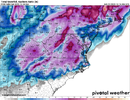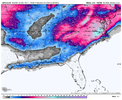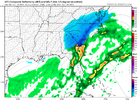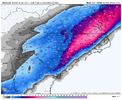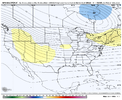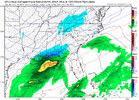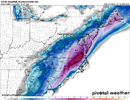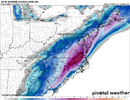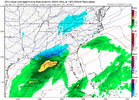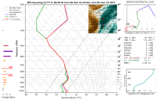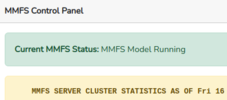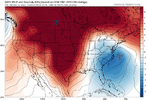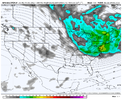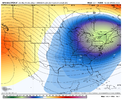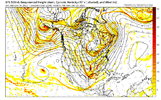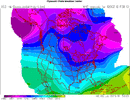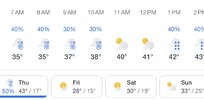-
Hello, please take a minute to check out our awesome content, contributed by the wonderful members of our community. We hope you'll add your own thoughts and opinions by making a free account!
You are using an out of date browser. It may not display this or other websites correctly.
You should upgrade or use an alternative browser.
You should upgrade or use an alternative browser.
Pattern Dazzling December
- Thread starter Rain Cold
- Start date
Somehow that might be crazier than the 12z run! Which I would have said was impossible. First storm is really the table setter on that run
26th storm looks even better.
iGRXY
Member
severestorm
Member
iGRXY
Member
NCSNOW
Member
Look at that tectbook V shape accum. That reminds me of crusher bombogenesis, just diff locationView attachment 126896
I95 monster. I really could see wide spread 4-8” even back in the western Carolinas honestly. That looks too light back this way but regardless easily 1-2 feet potential with these 2 systems
severestorm
Member
CMC's trending towards the GFS
NBAcentel
Member
Gefs looks worse then 18z tbh
accu35
Member
- Joined
- Jan 5, 2017
- Messages
- 8,722
- Reaction score
- 10,965
I’m trying but my phone won’t upload for some reasonShare?
Eh I would say the opposite looks like many have some snow but the track is much further west on many of them giving a lot of us rain.. maybe some backside snow. This is what I’m afraid we will see more of over the coming days. As this is more climo. I hope I’m wrong thoughWow!! First storm has some nice members
DadOfJax
Member
Definitely wouldn’t want to be anywhere but on the northwest side of bullseye for the 26th storm. North Alabama going to get smashed twice in 4 days!
NBAcentel
Member
Gefs is worse, more apps runners on the mean/Ne snows
I wouldn't be surprised if the first system cuts north/west and the second system (25th-26th) is the real blockbuster storm.Eh I would say the opposite looks like many have some snow but the track is much further west on many of them giving a lot of us rain.. maybe some backside snow. This is what I’m afraid we will see more of over the coming days. As this is more climo. I hope I’m wrong though
severestorm
Member
im leaning toward this tooI wouldn't be surprised if the first system cuts north/west and the second system (25th-26th) is the real blockbuster storm.
iGRXY
Member
First storm is a 2 prong level for success. Need the TPV to get out ahead of our wave and situate itself over the GL, need the ridge out west to really pump and help the wave dig to get the moisture cranked up. I’m 50/50 on the first event. There’s clearly enough noise for the possibility but as others have alluded to, it’s an extremely fine line between that and an apps cutter and CAD cold rain. The 2nd system you’re going to have Arctic air in place and the first system as confluence with an already pumped up western ridge. I’m more like 75/25 that it will succeed right now.
LukeBarrette
im north of 90% of people on here so yeah
Meteorology Student
Member
2024 Supporter
2017-2023 Supporter
Still so many different solutions on the GEFS, we got a long way to go boys
iGRXY
Member
something i thought was interesting is that the amount of variance in the ensembles actually went up in how it handles the trough dropping into the plains. this is surface pressure but since surface pressure is just going to reflect what's going on in the upper atmosphere i think its a fine enough proxy. seems like there's a forecasting problem upstream that's giving the GFS a hard time, thus causing differences in the timing/position of that trough. main point- don't think any solution is off the table, this will require some patience, you know the drill, etc.
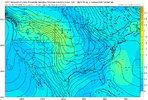

iGRXY
Member
iGRXY
Member
Sub 150 hours to even start getting an idea like usual.something i thought was interesting is that the amount of variance in the ensembles actually went up in how it handles the trough dropping into the plains. this is surface pressure but since surface pressure is just going to reflect what's going on in the upper atmosphere i think its a fine enough proxy. seems like there's a forecasting problem upstream that's giving the GFS a hard time, thus causing differences in the timing/position of that trough. main point- don't think any solution is off the table, this will require some patience, you know the drill, etc.
View attachment 126912
I’m with you guys. I think we’re pulling for the bomb out of the Arctic to set the table for a big overrunning event. That’s our wheelhouse. Wave dives in bringing the Siberian express, bombs out underneath that -NAO, slowly pulls out as a big 50/50 low, strong high pressure builds in then a new low rides that boundary out.
iGRXY
Member
GEFS should be heavier on the precip and looking at the maps that appears to be the case over the Deep South.
DadOfJax
Member
Great look on all globals….and anyone trying to use the ICON to thwart them is, well, deserving of a re-block!
Piedmont NC might see some freezing fog tonight! Forecast lows right around freezing for much of that region with patchy fog already developed
iGRXY
Member
GEFS is stronger but has more WAA
It is indeed warmer this run on the GEFS Mean, but man, this is a really good looking setup. Here is a comparison of last night's GEFS vs. tonight's. More western ridging, better -NAO couplet, and that negative anomaly over LA/MS (the storm wave) is in a really good spot (well south). On top of that, we have the big storm going up into the northeast that drags the baroclinic zone / surface cold front all the way into the Gulf and SE Coast waters, so that's a great starting point for storm #2's surface low track. The setup is there. Just got to see it all come togetherGEFS is stronger but has more WAA

If you’re still not ready to grieve the first storm .. that’s okay.. just don’t look at the euro and continue to hold out hope..

